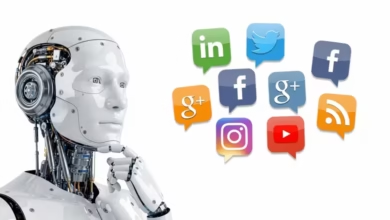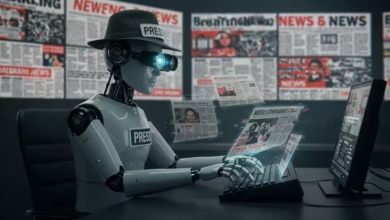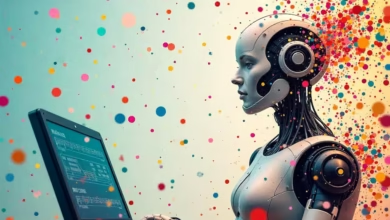Can AI Be Creative? Understanding Generative Models in Art and Music

In the blog post titled Can AI Be Creative? Understanding Generative Models in Art and Music, the author delves into the fascinating realm of generative AI creativity. It explores how artificial intelligence intersects with artistic expression, transforming the landscapes of art and music. The article contrasts traditional creative processes with AI-generated works, highlighting the unique contributions and challenges that AI brings to the creative field. Additionally, it encourages readers to embrace the potential of AI creativity today, suggesting paths for artists and musicians to integrate these technologies into their practice. By examining the capabilities and limitations of generative models, the post provides a comprehensive overview of how the future of creativity may be shaped by AI advancements.
Exploring The Intersection Of AI And Creativity
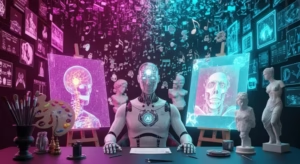
The advent of generative AI creativity has sparked significant discussions among artists, musicians, and technologists about the potential of AI to serve as a tool for creative expression. Unlike traditional artistic processes that rely solely on human intuition and skill, AI art tools leverage complex algorithms to analyze and synthesize vast amounts of data. This not only broadens the scope of creative possibilities but also challenges conventional definitions of what it means to be creative. As AI continues to evolve, it raises questions about authorship, originality, and the role of human artists in a rapidly changing landscape.
Key Concepts To Understand:
- Generative models: Algorithms that create new content based on learned patterns.
- Data training: The process through which AI learns from existing artworks or music.
- Collaboration: AI as a partner in the creative process rather than a replacement.
- Interactivity: The ability for users to interact with AI-generated content.
- Ethics: Considerations regarding copyright and ownership of AI-generated works.
- Innovation: How AI inspires new artistic styles and genres.
- Expansive creativity: The limitless possibilities that AI brings to the creative sector.
As artists begin to embrace AI art tools, the fusion of human vision with machine intelligence leads to groundbreaking results that challenge our perceptions of art and music. The integration of generative AI creativity in these fields is not merely about creating art but about enhancing our understanding of creativity itself. By recognizing the implications of these advancements, we can better appreciate the evolving relationship between technology and creativity, paving the way for future collaborations that merge the best of both worlds.
How Generative AI Transforms Art And Music
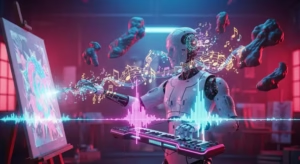
Generative AI is reshaping the landscape of creative expression, manifesting profound changes particularly in art and music. With the advent of sophisticated algorithms, artists and musicians are capitalizing on these tools to push the boundaries of their creativity. Generative models such as Generative Adversarial Networks (GANs) are at the forefront of this transformation, enabling the creation of original pieces that challenge our understanding of authorship and creativity itself. By blending human insight with computational power, generative AI is not just a tool for artists; it is becoming an integral partner in the creative process.
This partnership between human intuition and AI capabilities raises intriguing questions about the nature of creativity. The intersection of technology and artistic expression has led to the development of unique forms of artwork and music that are often indistinguishable from human-made pieces. As artists explore new avenues, they can utilize AI-generated elements that may evoke different emotional responses and ideas. The results are often surprising, pushing the creative envelope and inviting broader discussions about the implications of AI in the arts.
The Role Of GANs In Art Creation
GANs serve as a pivotal technology in the realm of generative art. These models consist of two neural networks that work in tandem: a generator that creates new content and a discriminator that assesses the authenticity of the generated output. This interplay allows GANs to produce incredibly realistic and complex art pieces, often blurring the lines between machine-generated and human-crafted works. As a result, artists leverage GANs to explore novel styles and techniques, leading to innovative art movements that celebrate the fusion of technology and creativity.
Steps To Utilize AI Music Generation:
- Define your musical goals: Determine the genre, mood, and style you wish to explore.
- Choose the right AI tools: Research AI music generation platforms that suit your needs, such as OpenAI’s MuseNet or Google’s Magenta.
- Gather training data: Collect a diverse set of musical samples that will guide the AI in understanding your preferences.
- Train the AI: Input your data and allow the AI to learn patterns and structures from it.
- Generate music: Utilize the trained model to create new compositions based on your initial goals.
- Refine the output: Edit and modify the generated music to align more closely with your artistic vision.
- Collaborate: Consider collaborating with other artists or musicians to further enhance the generated pieces.
Incorporating AI into the creative process not only enhances artistic output but also broadens the scope of what can be considered original work. This evolution presents both opportunities and challenges, encouraging artists and musicians to confront their perceptions of creativity and ownership in a technology-driven world. As generative AI continues to advance, its role in art and music will likely expand, resulting in even more revolutionary creative expressions for years to come.
Comparing Traditional And AI-Generated Creative Works

As we delve into the world of generative AI creativity, it is essential to understand the differences between traditional creative works and those produced by AI art tools. Traditional artists use their emotions, experiences, and personal insights to create art or music, often embedding their unique worldview into their creations. In contrast, AI-generated works primarily rely on algorithms and data sets, analyzing vast amounts of existing art to generate new pieces. This raises the question: can a machine truly be creative, or is it simply emulating human creativity?
To facilitate a clearer comparison, consider how creative machine learning operates. While both approaches yield fascinating outcomes, the motivation and process behind these works vary. Traditional artists often engage in a personal and emotional journey, whereas AI systems draw deeply from their training data to produce outputs that mimic human creativity without the underlying human sensibility. This fundamental distinction shapes the audience’s perception of value and authenticity in art and music.
Comparison of Traditional and AI-Generated Creative Works
| Aspect | Traditional Works | AI-Generated Works |
|---|---|---|
| Creativity Source | Human Emotion & Experience | Data Analysis & Algorithms |
| Creation Process | Intuitive & Personal | Structured & Programmed |
| Ownership | Individual Authorship | Collective Dataset |
| Market Value | Often High Due to Human Touch | Varies Based on Novelty |
Pros And Cons Of Both Approaches:
- Pros of Traditional Art: Unique perspective and emotional depth.
- Cons of Traditional Art: Subjective interpretation can limit mass appeal.
- Pros of AI Art Tools: Efficiency and the ability to generate vast quantities of work.
- Cons of AI Art Tools: Lacks emotional context and genuine creativity.
- Pros of Creative Machine Learning: Blends styles to create innovative pieces.
- Cons of Creative Machine Learning: Dependent on quality and diversity of training data.
Ultimately, both traditional and AI-generated works contribute to the evolving landscape of creativity. The rise of generative AI creativity challenges our understanding of artistic value and questions the role of the artist in the digital age. As AI art tools advance, they not only produce captivating pieces but also provoke discussions about what constitutes true art and the essence of creativity itself.
Case Studies Of AI Art Tools
Several notable case studies illustrate the capabilities and impact of AI art tools in contemporary creativity. For instance, OpenAI’s DALL-E projects generated impressive pieces by transforming textual descriptions into stunning images, showcasing the potential for laypeople to craft art through simple prompts. Similarly, programs like AIVA (Artificial Intelligence Virtual Artist) have revolutionized music composition by using algorithms that analyze established musical works, culminating in unique compositions that rival human creations.
Taking Action: Embracing AI Creativity Today

Embracing generative AI creativity offers an exciting opportunity for artists and musicians to enhance their work and explore new frontiers. The realm of AI music generation is rapidly evolving, pushing the boundaries of what is considered traditional creativity. Artists can now leverage these technologies to create innovative pieces that blend human intuition with machine learning. By understanding and utilizing generative AI tools, creatives can not only streamline their workflow but also discover unique styles and ideas that they might not have encountered otherwise.
Actionable Steps To Get Started:
- Research various generative AI tools and platforms.
- Experiment with free online AI art and music generation applications.
- Join communities focused on AI creativity to share insights and collaborate.
- Take online courses to understand the technical aspects of AI in creativity.
- Create a project that combines your original work with AI-generated elements.
- Gather feedback on your projects to iteratively improve your techniques.
- Stay updated on the latest advancements in generative AI technologies.
The key to effectively integrating generative AI creativity into your practice lies in experimentation and adaptation. By actively engaging with AI technologies, you can cultivate a unique artistic voice that resonates in an evolving digital landscape. Harnessing AI not only democratizes creativity but also enriches the artistic process, allowing for collaboration between human insight and machine intelligence.
Briefing Document: The Intersection of AI and Creativity in Art and Music
This briefing document summarizes the key themes and important insights from the provided source, “Can AI Be Creative? Understanding Generative Models in Art and Music – The Future of Artificial Intelligence.” It explores the evolving relationship between artificial intelligence and artistic expression, highlighting the transformative impact of generative AI on art and music.
I. The Rise of Generative AI in Creative Fields
The article asserts that “the advent of generative AI creativity has sparked significant discussions among artists, musicians, and technologists about the potential of AI to serve as a tool for creative expression.” Unlike traditional artistic methods, AI leverages complex algorithms to analyze and synthesize vast datasets, expanding creative possibilities and challenging conventional definitions of creativity.
Key Concepts to Understand:
- Generative Models: Algorithms that create new content based on learned patterns.
- Data Training: The process by which AI learns from existing artworks or music.
- Collaboration: AI functions as a partner, not a replacement, in the creative process.
- Interactivity: Users can interact with AI-generated content.
- Ethics: Critical considerations include copyright and ownership of AI-generated works.
- Innovation: AI inspires new artistic styles and genres.
- Expansive Creativity: AI unlocks limitless possibilities in the creative sector.
The source emphasizes that the integration of generative AI is “not merely about creating art but about enhancing our understanding of creativity itself,” fostering a fusion of human vision and machine intelligence that leads to groundbreaking results.
II. How Generative AI Transforms Art and Music
Generative AI, particularly through models like Generative Adversarial Networks (GANs), is profoundly reshaping the creative landscape. These tools enable the creation of original pieces that blur the lines between human-made and machine-generated works.
The Role of GANs in Art Creation:
GANs are a pivotal technology, consisting of two neural networks:
- A generator that creates new content.
- A discriminator that assesses the authenticity of the generated output.
This interplay allows GANs to produce “incredibly realistic and complex art pieces,” facilitating the exploration of novel styles and techniques.
Steps to Utilize AI Music Generation:
The article provides a clear, actionable guide for leveraging AI in music creation:
- Define musical goals: Determine genre, mood, and style.
- Choose AI tools: Select appropriate platforms (e.g., OpenAI’s MuseNet, Google’s Magenta).
- Gather training data: Collect diverse musical samples.
- Train the AI: Allow the AI to learn patterns from the data.
- Generate music: Create new compositions using the trained model.
- Refine the output: Edit and modify the generated music to align with artistic vision.
- Collaborate: Partner with other artists to enhance generated pieces.
This evolution presents both opportunities and challenges, pushing artists and musicians to reconsider their perceptions of creativity and ownership in a technology-driven world.
III. Comparing Traditional and AI-Generated Creative Works
A central discussion point is the distinction between traditional and AI-generated creative works.
- Traditional artists imbue their work with “emotions, experiences, and personal insights,” reflecting their unique worldview.
- AI-generated works rely on “algorithms and data sets, analyzing vast amounts of existing art to generate new pieces.”
This fundamental difference raises the question: “can a machine truly be creative, or is it simply emulating human creativity?” While both approaches yield fascinating outcomes, the underlying motivation and process vary. AI systems mimic human creativity without the inherent “human sensibility,” which impacts the audience’s perception of value and authenticity.
Comparison Table Highlights:
AspectTraditional WorksAI-Generated WorksCreativity SourceHuman Emotion & ExperienceData Analysis & AlgorithmsCreation ProcessIntuitive & PersonalStructured & ProgrammedOwnershipIndividual AuthorshipCollective DatasetMarket ValueOften High Due to Human TouchVaries Based on NoveltyPros and Cons of Both Approaches:
- Traditional Art Pros: Unique perspective, emotional depth.
- Traditional Art Cons: Subjective interpretation can limit mass appeal.
- AI Art Tools Pros: Efficiency, ability to generate vast quantities of work.
- AI Art Tools Cons: Lacks emotional context and genuine creativity.
- Creative Machine Learning Pros: Blends styles to create innovative pieces.
- Creative Machine Learning Cons: Dependent on quality and diversity of training data.
The article concludes that “the rise of generative AI creativity challenges our understanding of artistic value and questions the role of the artist in the digital age.”
IV. Embracing AI Creativity Today
The source encourages artists and musicians to embrace generative AI as an opportunity to enhance their work and explore new frontiers. By integrating AI tools, creatives can streamline workflows, discover unique styles, and foster a “collaboration between human insight and machine intelligence.”
Actionable Steps to Get Started:
- Research various generative AI tools and platforms.
- Experiment with free online AI art and music generation applications.
- Join communities focused on AI creativity.
- Take online courses on technical aspects of AI in creativity.
- Create a project combining original work with AI-generated elements.
- Gather feedback to iteratively improve techniques.
- Stay updated on the latest advancements in generative AI technologies.
The key to effective integration is “experimentation and adaptation,” allowing artists to cultivate a unique artistic voice in an evolving digital landscape. AI not only democratizes creativity but also enriches the artistic process.
Homepage / humanaifuture.com
For similar articles, please visit: AI in Art, Creativity & Media
🎧 Listen to the Podcast
Want to explore this topic in more depth? Listen to the full podcast for more insights and expert commentary.
▶️ Play on Google DriveNo sign-up needed — just click and listen.
How do Generative Adversarial Networks (GANs) contribute to AI art creation?
Generative Adversarial Networks (GANs) are a pivotal technology in generative art. They consist of two neural networks: a generator and a discriminator. The generator's role is to create new content, while the discriminator evaluates the authenticity of that generated output, comparing it against real data. This adversarial interplay allows GANs to produce incredibly realistic and complex art pieces, often blurring the lines between machine-generated and human-crafted works. Artists utilize GANs to explore novel styles and techniques, fostering innovative art movements that integrate technology and creativity.
What are the key differences between traditional and AI-generated creative works?
The main differences lie in their source of creativity, creation process, and ownership. Traditional works stem from human emotion, experience, and personal insights, resulting in an intuitive and personal creation process with individual authorship. AI-generated works, conversely, rely on data analysis and algorithms, drawing from vast datasets to mimic human creativity without genuine human sensibility. The creation process for AI is structured and programmed, and ownership can be linked to collective datasets rather than a single artist. While both can yield fascinating outcomes, traditional art offers unique perspectives and emotional depth, whereas AI art provides efficiency and the ability to generate vast quantities of work, though it may lack emotional context.
What are the main ethical considerations regarding AI-generated works?
The primary ethical considerations surrounding AI-generated works revolve around copyright and ownership. As AI systems learn from existing artworks and music to create new content, questions arise about who owns the rights to the AI's output, especially when it draws heavily from copyrighted material. This challenges traditional notions of individual authorship and intellectual property in a landscape where collective datasets inform the creative process.
What steps can artists and musicians take to utilize AI music generation?
Artists and musicians can follow several steps to effectively utilize AI music generation:
- Define musical goals: Determine the desired genre, mood, and style.
- Choose AI tools: Research and select appropriate AI music generation platforms (e.g., OpenAI’s MuseNet, Google’s Magenta).
- Gather training data: Collect diverse musical samples to guide the AI.
- Train the AI: Input the data and allow the AI to learn patterns.
- Generate music: Create new compositions using the trained model.
- Refine the output: Edit and modify the generated music to align with artistic vision.
- Collaborate: Consider working with other artists to enhance the pieces further.
What are the pros and cons of using AI art tools compared to traditional methods?
Pros of AI Art Tools:
- Efficiency: Ability to generate vast quantities of work quickly.
- Innovation: Blends styles to create novel and unexpected pieces.
- Expansive creativity: Broadens the scope of creative possibilities.
- Democratization: Allows laypeople to create art through simple prompts.
Cons of AI Art Tools:
- Lacks emotional context: Does not possess genuine human emotions or personal insights.
- Dependent on data quality: Output quality and originality are limited by the diversity and quality of training data.
- Authenticity concerns: Raises questions about what constitutes "true" creativity or art without human sensibility.
How is AI viewed in the creative process: as a replacement or a partner?
The provided sources consistently present AI as a partner in the creative process rather than a replacement for human artists. The integration of AI tools is seen as a fusion of human vision with machine intelligence, leading to groundbreaking results. This partnership enhances artistic output, broadens the scope of original work, and encourages collaboration between human intuition and machine learning. AI is positioned as a tool that can streamline workflows, help artists discover unique styles, and enrich the artistic process.
What are some actionable steps for artists and musicians to embrace generative AI creativity today?
To embrace generative AI creativity today, artists and musicians can:
- Research: Explore various generative AI tools and platforms available.
- Experiment: Try out free online AI art and music generation applications.
- Engage: Join communities focused on AI creativity for sharing insights and collaboration.
- Educate: Take online courses to understand the technical aspects of AI in creativity.
- Create: Develop projects that combine original work with AI-generated elements.
- Iterate: Gather feedback on projects to continuously improve techniques.
- Stay updated: Keep abreast of the latest advancements in generative AI technologies.


